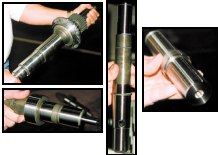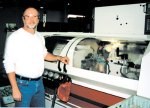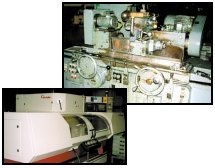Shop Adds CNC Grinding To Its Mix
Of all the metalworking processes, grinding is probably the most application specific. In a job shop environment, however, flexibility is the key to successful grinding. Here's a look at how one captive job shop successfully transitioned from manual to CNC grinding while standardizing its grinding process parameters to accommodate the demands of low volume, high mix production requirements.
Pretty much every job shop looks for process flexibility from the machine tools it selects. These shops need to be process agile because of the nature of the work they do for their customers.
Often these jobs are short notice, short delivery and on short margin. It's necessary to manufacture efficiently to have a chance of getting the job in the first place. Once in house, making good parts in ways that make the shop money becomes job one.
Job shops tend to be creative in ways that help streamline the metalworking process to maximize productive machining time and minimize costly non-productive time. We visited Hobart Corporation's manufacturing plant in Hillsboro, Ohio, to find out how it has changed to reflect job shop manufacturing realities. Called plant 31, it is a captive job shop that makes food wrappers, package labelers, and the world famous Hobart line of mixers.
The company's plant 31 has been successful in implementing numerous techniques to increase throughput and reduce cost while maintaining quality. Nowhere are these efforts more evident than in the shop's grinding department, which has gone from manual grinding to full CNC.
We talked to Hobart's Dick Valentine, manufacturing manager, and Paul Conklin, senior manufacturing engineer, about the tools and techniques they use to continuously upgrade their grinding process.
A Little Background
Built in 1970, Hobart's Hillsboro plant has undergone many changes in the past 30 years. Several expansions have brought the manufacturing space to just under 215,000 square feet with 346 employees.
The latest expansion was in 1994. It was done to accommodate the addition of the Hobart mixer line, which was transferred from the company's headquarters in Troy, Ohio. "For a hundred years," says Mr. Valentine, "the company manufactured mixers at the Troy plant. We looked at the product line move to our plant as a chance to re-evaluate how these mixers were manufactured."
Grinding was an example of where some process inroads could be made quickly and with fairly dramatic results. "When the mixer line moved to our plant," recalls Mr. Valentine, "we inherited the machines and processes that had been used to make them. For OD grinding we had five 1950s vintage OD machines, good machines, but all manual."
Prior to receiving the mixer product line, plant 31 manufactured wrapping and labeling machines for the food industry. The plant's manufacturing was already well on the way to implementing CNC operations across the milling and turning departments.
The old manual grinders were simply not in keeping with the manufacturing direction the shop had taken. "Even though we had no experience with CNC grinding," says Mr. Valentine, "we had a good idea of what we needed. Basically we wanted a good OD grinder that could do ID work in a pinch."
Organizing The Search
The search for CNC grinder replacements for the old manuals became Mr. Valentine's project. Systematically, he put together an evaluation spreadsheet to compare various grinders that had potential to meet Hobart's needs.
"It was a good exercise," says Mr. Valentine, "because we had not previously worked with CNC grinders at our plant. Evaluating the machines was an education."
Five competitive grinders were evaluated in 33 categories to determine the best machine for plant 31's manufacturing needs. "Basically, I reviewed literature and advertising to determine the specification criteria," says Mr. Valentine.
A point system assigned a weighted value to each category as it related to Hobart's applications. This helped make comparisons as equal as possible. Live demonstrations were requested for each brand.
The evaluation determined that from a design and reliability perspective all five were fairly equal. In addition, price was comparable among the five when optional and standard features were balanced out.
Most of the differences were noted in firmware and software, which tended to point each machine to a particular manufacturing niche. Based on Hillsboro plant 31's current product mix and the shop's need for maximum flexibility, the model S 30 from Studer (now a division of United Grinding) was chosen.
"Because of the close results in between the five machines we looked at," says Mr. Valentine, "I put a caveat in my evaluation that said if our production mix or volume requirements changed, a new evaluation would be in order."
Wheel Deal
Of course grinding is a complex process. Many variables make up a successful grinding application with the grinding wheel being among the most critical.
Hobart also undertook an evaluation of grinding wheel manufacturers. Like the search for a machine tool, Mr. Valentine orchestrated a demonstrable "bake-off" between two grinding wheel manufacturers.
"CNC grinding was new to us," says Mr. Valentine. "We selected two wheel makers and explained to them what our applications were and that flexibility was an important consideration. I basically told them, I have two machines. I'm putting one wheel brand on each machine and we'll see which does the job. That got their attention, so we received a lot of application help to refine the wheel material for our jobs. After several attempts using different formulations, we found using a ceramic oxide resin wheel with 60 grit was optimum for the different parts we put across the grinding machines.
"The ceramic grains are sharp and tend to cut our various materials more efficiently," says Mr. Conklin. "We didn't want to change wheels for each job. The ceramic wheel gave the best general purpose grinding range. Moreover, at the high grinding speeds these CNCs were capable of, heat generation was a concern. After evaluating several formulas, ceramic gave us the best combination of metal removal, without any microscopic stress fractures from heat. In addition, because of the more efficient cutting, warpage was eliminated."
Results
The CNC grinders were only installed at Hobart a couple of years ago. Even so, there have already been positive results for the plant's grinding operation.
From the start, plant 31 was able to replace four of its five manual machines with two CNC grinders. The fifth manual, inherited from the Troy plant, is kept as a surplus machine for production backup.
In terms of operators, the two CNC grinders reduced the labor content of the grinding operation to one operator per shift. Previously the five manual machines required an operator for each machine, each shift. With skilled operators in short supply and because of the company's cross training programs, other areas of the plant absorbed these surplus operators.
Typical lot sizes for plant 31 are 50 to 150 pieces. Most jobs now have only two setups. With the manual machines, there were as many as 13 separate setups, one for each diameter and radius. This was reduced to two for most jobs.
Most of the material is 8620 steel and 4140 stainless at 62Rc. Many of the parts are carburized. Finest finish requirement is 10 Ra for seal surfaces. Typically micro finish is 15 Ra.
In operation, the CNC grinders allow Hobart to combine multiple radii without re-dressing the wheel. This has saved the grinding department significant time in setup and operation.
"Some of our shafts have multiple radii in addition to multiple diameters," says Mr.
Valentine. "We may have a 0.030 inch radius and a 0.109 inch radius on the same shaft. On the manual grinders, each of those radii, and any others, had to be dressed into the wheel in sequence. That took a lot of cycle time. With the CNC grinder, we need only dress the smaller radius onto the wheel. An axis interpolation macro is then used to cut the bigger radii—like a single point turning tool. That's been a huge savings in time and wheels."
Another throughput enhancement that CNC grinding has provided Hobart is the ability to combine rough and finish operations in a single pass. Using a feature called adjustable feed rates, the wheel can be programmed to plunge to within 0.002 inch of finish size. Then the feed is automatically slowed for the final travel to size.
"We're able to keep the machine in the cut more than 80 percent of the time compared to 30 percent on the manuals," says Mr. Valentine. "This has resulted in a better than 30 percent cost reduction per shaft. Not only are we making more parts per hour at less cost, they are better parts. Scrap reduction has gone from $1,200 per month to less than $400 since introducing CNC grinding. Re-work has gone away completely."
All In The Family
Hobart's mixer line has nine standard models ranging from counter-top to free-standing industrial units. Each of these models has three or four shafts in the output transmission.
Sizes range from 6 to 26 inches in length with major diameters from 0.375 inch to 3 inches. All of the shafts are ground on the CNC grinders. All together, more than 50 different shafts are processed across the grinders.
Random processing of parts, based on MRP demands, means geometric variations from shaft to shaft can be minor or major, depending on the production sequence. CNC has helped streamline the changeover from part to part, reducing setup to a fraction of that required for the manuals.
Verification gaging is built into the grinding cycle to confirm part length and establish a datum point for the program. The grinder control automatically shifts the program based on this length measurement to allow for any location variation between the centers. "That saves a significant amount of setup time," says Mr. Valentine, "because the operator doesn't need to tram in the workpiece to locate the first feature."
Standardization
A primary responsibility for Hobart's plant 31 is to provide a steady supply of good parts. These are scheduled on a just-in-time basis so inventories are low or non-existent.
The shop is wired with Cimnet folders. Shop orders are sent on paper to the shop. Setup and work instructions are online inside folders. Dispatch comes from the MRP system at headquarters in Troy.
It calculates due dates and prioritizes the work sequence based on demand. It's a pull-through system. JIT inventory control is the driver for scheduling the work through plant 31.
Manufacturing without an inventory safety net means downtime is not an option. To ensure that its manufacturing stays online, Hobart has created back-up for most of its critical operations.
For example the two grinders are virtually identical. Proprietary programming that was provided with the machine made training relatively easy. Operation can interchange between the two machines.
"A novice can be up and programming in a week," says Mr. Valentine. "Our operators do the programming on the shopfloor. And they get paid a programming rate. There is little or no off-line programming done by our manufacturing engineers. This frees them to look at process enhancements and better methods rather than being tied to a programming task."
Mr. Valentine says that Fanuc compatibility is also important to plant 31. "One can argue about which CNC is best, but for our shop, because we move people around from department to department, compatibility of controls is important. We can take a program from our Mori Seiki machining center and change one code and the Haas runs the Mori program.
"Most of our fixturing is designed to run on more than one machine," says Mr. Valentine. "If, for example, one of our Makino machining centers is loaded or goes down, we can quickly shift work to another machine because of program and workholding compatibility."
What's In Store
Hobart's plant 31 has made excellent progress implementing CNC grinding from basically a standing start. The results of this technology are apparent in better throughput, lower production costs, better quality and reduced scrap and rework.
However, the plant isn't stopping to rest. "We're looking at superabrasives as a means to step production up another notch," says Mr. Valentine. "In addition, we plan to expand the use of our Cimnet folders system to eventually eliminate paper routers to the shopfloor all together."
What's key for Hobart, or any job shop, is to continuously look for processes, equipment and peripherals that maintain flexibility and agility on the shop floor while maximizing the in-cut time and production consistency.
Related Content
Choosing Your Carbide Grade: A Guide
Without an international standard for designating carbide grades or application ranges, users must rely on relative judgments and background knowledge for success.
Read MoreHow to Start a Swiss Machining Department From Scratch
When Shamrock Precision needed to cut production time of its bread-and-butter parts in half, it turned to a new type of machine tool and a new CAM system. Here’s how the company succeeded, despite the newness of it all.
Read MoreA New Milling 101: Milling Forces and Formulas
The forces involved in the milling process can be quantified, thus allowing mathematical tools to predict and control these forces. Formulas for calculating these forces accurately make it possible to optimize the quality of milling operations.
Read MoreChoosing a Five-Axis Machine Tool With Automation in Mind
While much focus is placed on the machinery that moves parts, the features most important for automating five-axis machining are arguably found in the machine tool itself.
Read MoreRead Next
The Cut Scene: The Finer Details of Large-Format Machining
Small details and features can have an outsized impact on large parts, such as Barbco’s collapsible utility drill head.
Read More3 Mistakes That Cause CNC Programs to Fail
Despite enhancements to manufacturing technology, there are still issues today that can cause programs to fail. These failures can cause lost time, scrapped parts, damaged machines and even injured operators.
Read More











.jpg;maxWidth=300;quality=90)












.png;maxWidth=300;quality=90)









